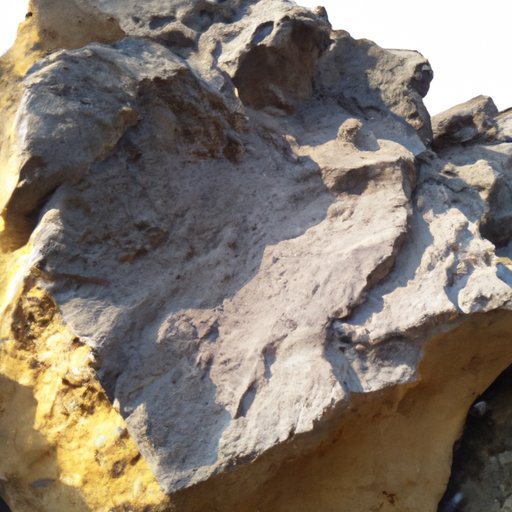Introduction
Abrasion is a process of physical wear and tear that occurs when two objects rub against each other. It is an important concept in many scientific fields, such as geology, engineering, and materials science. In this article, we will explore what abrasion is, how it works in the natural environment, its uses in geology and product manufacturing, its impact on human health and well-being, and its role in ancient and modern technologies.

Abrasion in the Natural Environment
Abrasion is caused by friction between two surfaces. In the natural environment, it can be caused by wind, water, or ice. For example, wind erodes the surface of rocks and sand, while water and ice can cause erosion of soil and other sediments. The effects of abrasion can include changes in the shape and texture of the surface, as well as the formation of small particles and dust.
The effects of abrasion can vary depending on the type of material being abraded. For example, softer materials, such as clay, are more susceptible to abrasion than harder materials, such as granite. In addition, the amount of abrasion that a material can withstand is largely determined by its strength, hardness, and porosity.
There are several solutions to abrasion in the natural environment, including the use of protective coatings, the installation of barriers, and the use of erosion-resistant materials. Protective coatings, such as paint or sealants, can help reduce the amount of abrasion that a material experiences. Barriers, such as fences or walls, can also help to prevent abrasion from occurring. Finally, erosion-resistant materials, such as concrete or asphalt, can be used to protect surfaces from the effects of abrasion.
Abrasion in Geology
In geology, abrasion is an important process in the formation of landscapes. As wind, water, and ice erode the surface of rocks and sediment, they create new landforms, such as canyons and valleys. Abrasion can also cause the formation of caves and tunnels, as well as the formation of beaches and coastal cliffs.
One example of abrasion in nature is the Grand Canyon in Arizona. This canyon was formed over millions of years through the erosion of the Colorado River. The river’s powerful currents and abrasive sediment wore away at the surrounding rock, creating the dramatic landscape that we see today.

Abrasion as a Tool for Creation
Abrasion is also used as a tool for creation in various industries. In product and artifact manufacturing, abrasion is used to shape and refine surfaces. For example, abrasive tools, such as grinding wheels, are used to remove excess material from metal parts. Abrasive techniques, such as sandblasting, are also used to create decorative patterns on glass and stone surfaces.
Abrasion is also used in everyday life. Sandpaper is commonly used to smooth wood surfaces, while steel wool is used to clean and polish metals. Abrasive cleaners are also used to remove dirt and grime from surfaces, such as kitchen countertops.
Impact on Human Health and Well-Being
While abrasion can be beneficial in many ways, it can also pose potential risks to human health and well-being. Inhalation of particles produced by abrasion can cause respiratory irritation and lung damage. In addition, contact with abrasive materials can cause skin irritation and allergic reactions.
To protect against the risks of abrasion, it is important to wear protective gear, such as goggles, gloves, and masks. It is also important to use appropriate ventilation when working with abrasive materials. Finally, it is important to ensure that all surfaces are properly cleaned after using abrasive tools or techniques.
Role of Abrasion in Ancient and Modern Technologies
Abrasion has been used for centuries in various technologies. In ancient times, abrasion was used to create stone tools and weapons, as well as to carve statues and monuments. Abrasive techniques, such as sandblasting, were also used to create decorative patterns on glass and pottery.
Today, abrasion is still used in many modern technologies. Abrasive tools, such as grinding wheels, are used to shape and refine metal parts. Abrasive techniques, such as sandblasting, are also used to create decorative patterns on glass and stone surfaces. In addition, abrasive processes, such as polishing, are used to improve the performance of cutting tools and machine parts.
Conclusion
Abrasion is a process of physical wear and tear that occurs when two objects rub against each other. This article has explored what abrasion is, its role in the natural environment, its uses in geology and product manufacturing, its effects on human health and well-being, and its applications in ancient and modern technologies. It is clear that abrasion plays an important role in many aspects of our lives, from the formation of landscapes to the production of everyday products. Further research is needed to fully understand the effects of abrasion on human health and the environment.
(Note: Is this article not meeting your expectations? Do you have knowledge or insights to share? Unlock new opportunities and expand your reach by joining our authors team. Click Registration to join us and share your expertise with our readers.)
